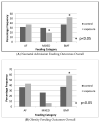Weekly Proactive Telephone Breastfeeding Standard Care by Lactation Consultants in the First Month Postpartum Prolongs Breastfeeding for Up to 6 Months
- PMID: 37432209
- PMCID: PMC10180720
- DOI: 10.3390/nu15092075
Weekly Proactive Telephone Breastfeeding Standard Care by Lactation Consultants in the First Month Postpartum Prolongs Breastfeeding for Up to 6 Months
Abstract
Many mothers, especially those with co-morbidities, do not achieve exclusive breastfeeding (EBF) for the first 6 months, with the loss of multiple health benefits including enhanced infant nutrition. We wished to evaluate whether proactive lactation consultant telephone advice in the first month postpartum improved breastfeeding rates for up to 6 months. A prospective cohort observational study was performed. Mother groupings included the following: Control (CG, n = 379)-standard postnatal care; Exposure (EG, n = 386)-standard postnatal care delivered by lactation consultant telephone contact for the first 3 weeks postpartum and then follow-up calls at 1, 3 and 6 months postpartum to ascertain breastfeeding status. Sore nipples (24%) and fussy/unsettled behaviour (14-19%) were common EG concerns. EG EBF rates were higher at 1 month (65% vs. 53%; p < 0.001), 3 months (57% vs. 49%; p = 0.041) and 6 months (45 vs. 33%; p < 0.001). EG EBF rates across the 6 months were higher for infants admitted to the NNU (52.9% vs. 37.5%, p = 0.003), obese mothers (58.3% vs. 37.2%, p < 0.001), mothers with depression (60.8% vs. 43.4%, p = 0.036) and all birth modes. Proactive early lactation advice significantly prolongs EBF and consequently enhances infant nutrition overall, including for mothers at risk of early breastfeeding cessation.
Keywords: exclusive breastfeeding; lactation consultant; telephone support.
Conflict of interest statement
The authors declare that there are no conflict of interest.
Figures




Similar articles
-
Does telephone lactation counselling improve breastfeeding practices? A randomised controlled trial.Int J Nurs Stud. 2013 Jan;50(1):16-25. doi: 10.1016/j.ijnurstu.2012.09.006. Epub 2012 Oct 17. Int J Nurs Stud. 2013. PMID: 23084438 Clinical Trial.
-
Assessing the impact of professional lactation support frequency, duration and delivery form on exclusive breastfeeding in Lebanese mothers.PLoS One. 2020 Sep 4;15(9):e0238735. doi: 10.1371/journal.pone.0238735. eCollection 2020. PLoS One. 2020. PMID: 32886727 Free PMC article.
-
Breastfeeding rates are high in a prenatal community support program targeting vulnerable women and offering enhanced postnatal lactation support: a prospective cohort study.Int J Equity Health. 2021 Mar 3;20(1):71. doi: 10.1186/s12939-021-01386-6. Int J Equity Health. 2021. PMID: 33658034 Free PMC article.
-
Breast-feeding and family planning: a review of the relationships between breast-feeding and family planning.Am J Clin Nutr. 1982 Jan;35(1):162-71. doi: 10.1093/ajcn/35.1.162. Am J Clin Nutr. 1982. PMID: 7039292 Review.
-
Breastfeeding Support Interventions by International Board Certified Lactation Consultants: A Systemic Review and Meta-Analysis.J Hum Lact. 2019 Aug;35(3):424-440. doi: 10.1177/0890334419851482. Epub 2019 Jun 17. J Hum Lact. 2019. PMID: 31206317
Cited by
-
Breastfeeding Practices and Postpartum Weight Retention in an Asian Cohort.Nutrients. 2024 Jul 8;16(13):2172. doi: 10.3390/nu16132172. Nutrients. 2024. PMID: 38999919 Free PMC article.
-
Effects of internet-based integrated care on breastfeeding outcomes and emotional well-being in primiparous women.Am J Transl Res. 2024 Sep 15;16(9):4808-4818. doi: 10.62347/UMKH2239. eCollection 2024. Am J Transl Res. 2024. PMID: 39398574 Free PMC article.
-
The effectiveness of real-time telelactation intervention on breastfeeding outcomes among employed mothers: a systematic review and meta-analysis.BMC Pregnancy Childbirth. 2025 Mar 25;25(1):341. doi: 10.1186/s12884-025-07440-3. BMC Pregnancy Childbirth. 2025. PMID: 40133932 Free PMC article.
-
Effects of an Online Theory-Based Educational Programme for Primiparous Women on Improving Breastfeeding-Related Outcomes: A Randomised Controlled Trial.Scand J Caring Sci. 2025 Mar;39(1):e13320. doi: 10.1111/scs.13320. Scand J Caring Sci. 2025. PMID: 39865520 Free PMC article. Clinical Trial.
References
-
- NHMRC (National Health and Medical Research Council) Infant Feeding Guidelines: Summary, Commonwealth of Australia, Canberra. [(accessed on 1 May 2018)];2013 Available online: https://www.nhmrc.gov.au/about-us/publications/infant-feeding-guidelines....
Publication types
MeSH terms
Grants and funding
LinkOut - more resources
Full Text Sources
Medical

